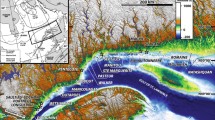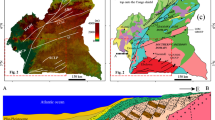Abstract
Reconstructing past delta front morphology is a challenging task, due to complex morphological formation processes. We have developed a methodological framework to reconstruct the delta front morphology by integrating the information from historical shorelines, spatial distribution of depositional environments, relative sea-level changes and a modern Digital Elevation Model (DEM). The delta front morphology was reconstructed based on spatial connections between mud basin morphology, subaerial DEM and the historical shoreline. In addition, available sedimentation data at the delta front was utilized to aid in reflecting complex morphological formation processes. Taking Macquarie Rivulet delta within Lake IlIawarra, Australia, as an example, we generated the historical delta morphology for 1892. The modelled sedimentation rate appears to be consistent with the measured ones. We have also applied this method to reconstruct the historical morphology in 1938 and 1981. The model results indicate a progressive infilling influenced by switching river mouth locations. The cautions and implications of this method are also discussed. An increased resolution of sedimentation data should be able to improve the accuracy of the model. The reconstructed morphologies, elucidating fundamental information about delta evolution and sediment mass volumes in the past, can be employed in management activities.





Similar content being viewed by others
References
Al-Nasrawi, A. K. M., Jones, B. G., and Hamylton, S., 2016. GIS-based modelling of vulnerability of coastal wetland ecosystems to human modifications during sea level rise and eco-geomorphic sustainability: a case study from Comerong Island, southeastern Australia. J Coast Res Spec Issue, 75, 33–37
Ashton, A.D., Murray, A.B., 2006. High-angle wave instability and emergent shoreline shapes: 1. Modeling of sand waves, flying spits, and capes. J Geophys Res Earth Surf 111, 1–19. https://doi.org/10.1029/2005JF000422
Barnes RJ (1991) The variogram sill and the sample variance. Math Geol 23:673–678. https://doi.org/10.1007/BF02065813
Blum MD, Roberts HH (2012) The Mississippi delta region: past, present, and future. Annu Rev Earth Planet Sci 40:655–683. https://doi.org/10.1146/annurev-earth-042711-105248
Bruun P (1988) The Bruun rule of erosion by sea-level rise: a discussion on large-scale two-and three-dimensional usages. J Coast Res 4:627–648. https://doi.org/10.2307/4297466
Chenhall BE, Yassini I, Depers AM, Caitcheon G, Jones BG, Batley GE, Ohmsen GS (1995) Anthropogenic marker evidence for accelerated sedimentation in Lake Illawarra, New South Wales, Australia. Environ Geol 26:124–135. https://doi.org/10.1007/BF00768326
Davis JC (2002) Statistics and Data Analysis in Geology. John C. Davis. In: Statistics and data analysis in geology, 3rd edn. John Wiley and Sons, Inc, New York. https://doi.org/10.1086/628074
Dean RG (1991) Equilibrium beach profiles : characteristics and applications. J Coast Res 7:53–84. https://doi.org/10.2307/4297805
Deng J, Zhang W, Harff J, Schneider R, Dudzinska-Nowak J, Terefenko P, Giza A, Furmanczyk K (2014) A numerical approach for approximating the historical morphology of wave-dominated coasts - a case study of the Pomeranian bight, southern Baltic Sea. Geomorphology 204:425–443. https://doi.org/10.1016/j.geomorph.2013.08.023
Deng J, Harff J, Li Y, Zhao Y, Zhang H (2016) Morphodynamics at the coastal zone in the Laizhou Bay, Bohai Sea. J Coast Res 74:59–69. https://doi.org/10.2112/SI74-006.1
Deng J, Jones BG, Rogers K, Woodroffe CD (2018) Wind influence on the orientation of estuarine landforms: an example from Lake Illawarra in southeastern Australia. Earth Surf Process Landf 43:2915–2925. https://doi.org/10.1002/esp.4459
Dickson ME, Walkden MJA, Hall JW (2007) Systemic impacts of climate change on an eroding coastal region over the twenty-first century. Clim Chang 84:141–166. https://doi.org/10.1007/s10584-006-9200-9
Edmonds DA (2012) Restoration sedimentology. Nat Geosci 5:758–759. https://doi.org/10.1038/ngeo1620
Giosan L, Syvitski J, Constantinescu S, Day J (2014) Climate change: protect the world’s deltas. Nature 516:31–33. https://doi.org/10.1038/516031a
Hamylton SM, Al-Nasrawi AKM, Jones BG, Hopley CA, Al Yazichi YM (2018) Geoinformatics vulnerability predictions of coastal ecosystems to sea-level rise in southeastern Australia. Geomatics, Nat Hazards Risk 9:645–661. https://doi.org/10.1080/19475705.2018.1470112
Hanslow DJ, Dela-Cruz J, Morris BD, Kinsela MA, Foulsham E, Linklater M, Pritchard TR (2016) Regional scale coastal mapping to underpin strategic land use planning in Southeast Australia. J Coast Res 75:987–991. https://doi.org/10.2112/SI75-198.1
Harff, J., Meyer, M., 2011. Coastlines of the Baltic Sea – zones of competition between geological processes and a changing climate: examples from the southern Baltic, in: the Baltic Sea basin. pp. 149–164. https://doi.org/10.1007/978-3-642-17220-5
Hopley CA (2013) Autocyclic, allocyclic and anthropogenic impacts on holocene delta evolution and future management implications. Macquarie Rivulet and Mullet / Hooka Creek , Lake Illawarra , New South Wales. University of Wollongong, Australia
Hopley CA, Jones BG, Puotinen M (2007) Assessing the recent (1834-2002) morphological evolution of a rapidly prograding delta within a GIS framework: Macquarie rivulet delta, Lake Illawarra, New South Wales. Aust J Earth Sci 54:1047–1056. https://doi.org/10.1080/08120090701615709
IPCC, 2013. The physical science basis. Contribution of working group I to the fifth assessment report of the intergovernmental panel on climate change, Climate Change https://doi.org/10.1017/CBO9781107415324.005
Kumbier K, Carvalho RC, Vafeidis AT, Woodroffe CD (2019) Comparing static and dynamic flood models in estuarine environments: a case study from south-East Australia. Mar Freshw Res. https://doi.org/10.1071/MF18239
Liu Y, Yang G, Hu L, Yao Z, Shi X, Liu S, Zhou L, Qiao S, Hu B, Wang G (2017) Sediment accumulation and budget in the Bohai Sea, Yellow Sea and East China Sea. Mar Geol 390:270–281. https://doi.org/10.1016/j.margeo.2017.06.004
Olea RA (1991) Geostatistical glossary and multilingual dictionary, International Association for Mathematical Geology Series. Oxford University Press
Paola C, Twilley RR, Edmonds DA, Kim W, Mohrig D, Parker G, Viparelli E, Voller VR (2011) Natural processes in delta restoration: application to the Mississippi Delta. Annu Rev Mar Sci 3:67–91. https://doi.org/10.1146/annurev-marine-120709-142856
Roy PS (1984) New south wales estuaries: their origin and evolution. In: Thom BG (ed) Coastal geomorphology in Australia. Academic Press, p 349
Roy PS, Williams RJ, Jones AR, Yassini I, Gibbs PJ, Coates B, West RJ, Scanes PR, Hudson JP, Nichol S (2001) Structure and function of south-east Australian estuaries. Estuar Coast Shelf Sci 53:351–384. https://doi.org/10.1006/ecss.2001.0796
Shapiro A, Botha JD (1991) Variogram fitting with a general class of conditionally nonnegative definite functions. Comput Stat Data Anal 11:87–96. https://doi.org/10.1016/0167-9473(91)90055-7
Sloss CR, Jones BG, Murray-Wallace CV, McClennen CE (2005) Holocene Sea level fluctuations and the sedimentary evolution of a barrier estuary: Lake Illawarra, New South Wales, Australia. J Coast Res 215:943–959. https://doi.org/10.2112/03-0110.1
Sloss CR, Jones BG, Brooke BP, Heijnis H, Murray-Wallace CV (2011) Contrasting sedimentation rates in Lake Illawarra and St Georges basin, two large barrier estuaries on the southeast coast of Australia. J Paleolimnol 46:561–577. https://doi.org/10.1007/s10933-011-9507-z
Syvitski JPM, Kettner A (2011) Sediment flux and the anthropocene. Philos Trans R Soc A Math Phys Eng Sci 369:957–975. https://doi.org/10.1098/rsta.2010.0329
Troedson, A.L., Hashimoto, T.R., Colquhoun, G.P., Ballard, J.C., 2015. Coastal quaternary geology data package for NSW [digital dataset]
Vitousek S, Barnard PL, Limber P, Erikson L, Cole B (2017) A model integrating longshore and cross-shore processes for predicting long-term shoreline response to climate change. J Geophys Res Earth Surf 122:782–806. https://doi.org/10.1002/2016JF004065
Webster R, Oliver MA (2008) Geostatistics for environmental scientists: second edition. https://doi.org/10.1002/9780470517277
Wei X, Wu C, Ni P, Mo W (2016) Holocene delta evolution and sediment flux of the Pearl River, southern China. J Quat Sci 31:484–494. https://doi.org/10.1002/jqs.2873
Woodroffe CD, Cowell PJ, Callaghan DP, Ranasinghe R, Jongejan R, Wainwright DJ, Barry SJ, Rogers K, Dougherty AJ (2012) Approaches to risk assessment on Australian coasts: a model framework for assessing risk and adaptation to climate change on Australian coasts. National Climate Change Adaptation Research Facility, Gold Coast
Zhang W, Harff J, Schneider R, Wu C (2010) Development of a modelling methodology for simulation of long-term morphological evolution of the southern Baltic coast. Ocean Dyn 60:1085–1114. https://doi.org/10.1007/s10236-010-0311-5
Acknowledgments
This study was supported by ARC Linkage project LP130101025 “Responses of estuaries to climate change: investigating their role as sediment sinks”, in collaboration with the Office of Environment and Heritage (NSW), the Australian Nuclear Science and Technology Organisation and Shoalhaven City and Bega Valley Shire Councils. The research project funded by the National Natural Science Foundation of China (NSFC, Grant No. 41806100) is also acknowledged. We also thank the comments by the anonymous reviewers and the editors.
Author information
Authors and Affiliations
Corresponding author
Additional information
Publisher’s note
Springer Nature remains neutral with regard to jurisdictional claims in published maps and institutional affiliations.
Appendix
Appendix
The morphological variation is described by the semi-variogram that evaluates the spatial correlations of the residuals of the observations after detrending the mean surface (Olea 1991). For a set of N observations at locations xi (i = 1, 2…., N), a regionalized variable h(x) represents the elevations. An estimator of experimental semi-variogram γ(d) is given below, where d is the distance between the pairs of observations:
The semi-variogram is a function of distance and is independent of the location. If the mean of the regionalized variable is stationary, the covariance is C(d) = C(0) - γ(d), where C(0) is the sample variance in the experimental semi-variogram. When the distance of a pair of observations is greater than a certain range r, they are no longer correlated and the semi-variance stops increasing and remains stable, which is called the sill and can be used to approximate the population variance (Barnes 1991). Anisotropy means that r varies in different directions, resulting in different spatial correlations depending on both the directions and distances of geospatial data. Even at small distances there is a small difference in semi-variances and this is called the nugget and represents measurement errors and can be considered as white noise δ.
One of the common mathematical functions to model the experimental semi-variogram is called the spherical model (Shapiro and Botha 1991), which is defined as:
where \( {\sigma}_0^2 \) is the sill and is equal to C(0) when the distance d is equal to or greater than the range r. The fitted semi-variogram model is then used as a distance-based weight of the kriging estimator. The kriging estimator is a family of generalized linear regression techniques (Webster and Oliver 2008) and the ordinary kriging estimator (Davis 2002) is given below:
where \( \widehat{Z}\left({x}_0\right) \) is an estimator at location x0; Z∗(xi) is the observation of the regionalized variable Z at location xi; u is the mean of the regionalized variable Z; and λi is the kriging weight between the values at location x0 and the values at location xi, which is derived from the semi-variogram model γ ′ (d). \( {\sum}_{i=1}^k{\lambda}_i \) is forced to be 1 to ensure unbiased estimates for all weights obtained when the error variances are as small as possible, and the mean error is zero. In the ordinary kriging, there is no need to know the mean value u or the trend, as \( {\sum}_{i=1}^k{\lambda}_i \)is equal to 1.0.
Rights and permissions
About this article
Cite this article
Deng, J., Yao, Q., Jones, B.G. et al. A methodological framework for reconstructing historical delta front morphology: case study at Macquarie rivulet delta within Lake Illawarra, Australia. J Coast Conserv 23, 717–726 (2019). https://doi.org/10.1007/s11852-019-00699-7
Received:
Revised:
Accepted:
Published:
Issue Date:
DOI: https://doi.org/10.1007/s11852-019-00699-7




